
|
||
|
Portland art blog + news + exhibition reviews + galleries + contemporary northwest art
|
||
Vantage at Archer Gallery Many of man's most lasting cultural achievements have been devoted to the engagement
and or self conscious positioning between viewer and the observed.
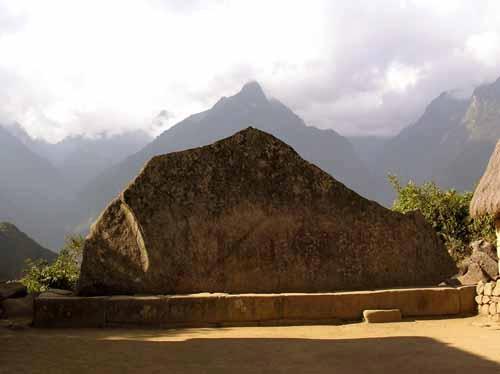
The sacred rock at Machu Picchu was carved to mimic the profile in alignment to the distant peak. 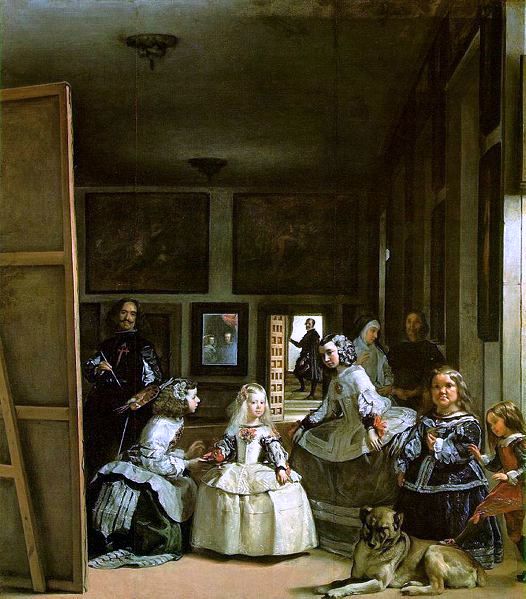
Velasquez's Las Meninas revealed the intrigues of political positioning as pictorial space 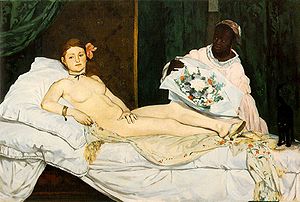
Manet changed Western Art when his Olympia gazed out at salon goers. It was painted specifically to engage and acknowledge the presence of viewers… somewhat breaking Aristotle's axiom of ambivalence as a necessity for great art. 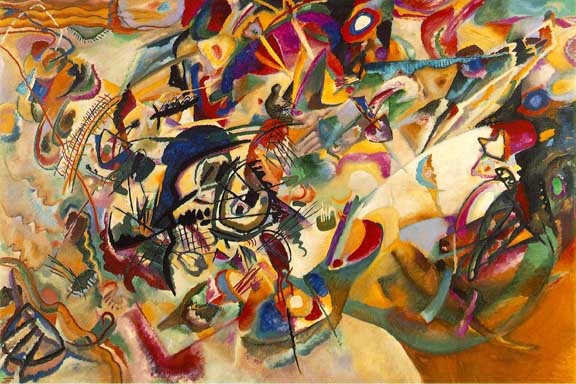
Kandinsky's drive for abstraction was born in part from his desire for a rapport of form and color with the viewers akin to music's connection to listeners. Later, the work of Donald Judd, Walter de Maria, Michael Heizer, Robert Irwin, James Turrell and Richard Serra have all conversed eloquently in the way human beings kinesthetically connect where they are to what they see. Less abstract, photographers like Ansel Adams, Andreas Gursky and Edward Burtynsky all suggest a certain point of view… with most photography it's inherent. 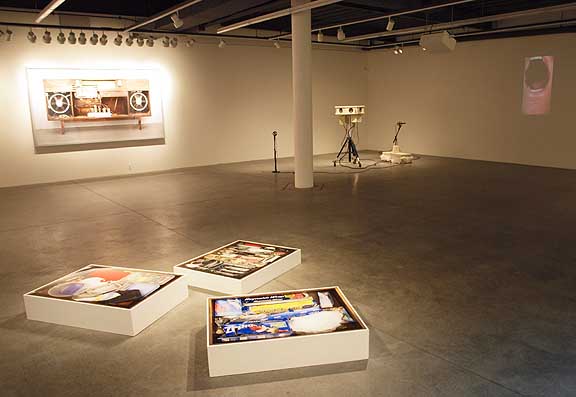 Vantage (L to R) Layman, Pond and Slappe Picking up the thread, the Archer Gallery's Vantage is a tightly curated and well presented rumination on the participatory rapport between art subject and viewers. As new Archer curator Blake Shell's first big show (that she programmed) it is telling that she chose to scrap all of the movable walls that once cluttered the fine space, affording all pieces sight line opportunities with one another. It's a welcome break from many northwest curators' fetish of cloistered, discreet spaces that keep works from forming interesting visual and conceptual aggregates. It also forces the show to have less work. Thus, Vantage is noteworthy for how good it looks as a gestalt. Pay attention Portland and Seattle galleries and curators, Vancouver Washington just showed you how it's done! 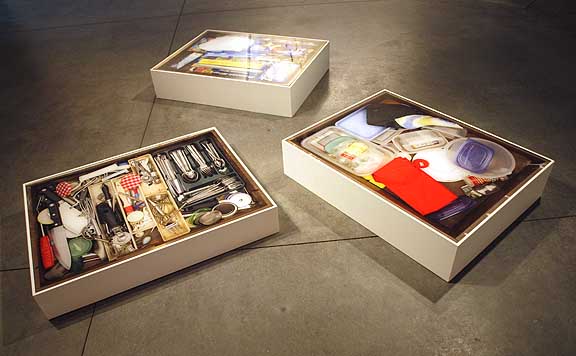 Layman's Drawers, 2008 When one first enters the space Seattle photographer Isaac Layman's wall and floor based works first come into view. His glossy, out scaled pieces like "Sink With Lettuce" allow us the opportunity to view a kitchen sink as if we were the size of a rabbit. A daunting edifice of house chores to be sure but I prefer his slightly outsized "Drawers" on the floor. These works become more than a photograph when removed from the wall and are placed on the floor… they become more illusionary simulacra than the illusory documentation of the wall works. Also, because they are on the floor the drawers are more generous to the viewer because we can shift our vantage point more radically. This is key, as it allows us to test our perception of Layman's illusion and comparative scale more thoroughly. It's the equivalent of a magician who allows the audience more angles from which to evaluate their trick. For me it's way more pleasurable since oversized hyper-real photos are hardly rare in contemporary art. Like a lot of Seattle art it's strong on execution but not exactly cutting edge… it just looks and acts like "contemporary art." My challenge to Layman it to push this much farther in more unexpected, original, possibly less fussed ways. To be fair, this is a problem for all photographers, not just Layman. 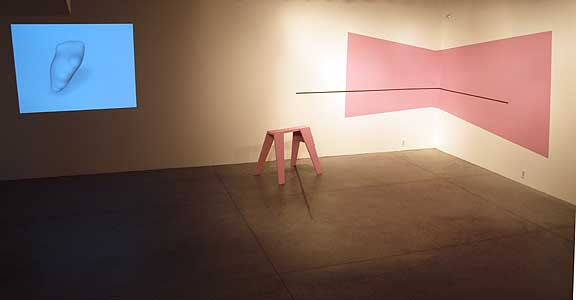 Levin (L), Bawa (R) From Pittsburgh, Golan Levin's fascinating "Merce's Isosurface" is an animated video made from the captured coordinates of Merce Cunningham's hands. The resulting schematic displays the kinesthetic topography of his movements… which could just as easily be the mapped movements of protons and neutrons in an atom. Here the vantage is through the filter of computerization yet the wiggles and bobbing blobbings read as being sourced from something alive though algorithms designed to produce similar results are being refined by Hollywood and video games all the time. Since we use satellites and other instruments to schematize and render the universe, this piece reminds the viewer of the role perceptive aids or tools play in our understanding of where and how things are. As the saying goes, out of sight out of mind and computers increasingly augment, translate and transform the topography of human perception/experience. This augmented and shifted reality is so common that this piece derives most of its interest from the fact that it is in fact Merce Cunningham who is the one making this puppet dance. Atlanta's Avantika Bawa's "Points (for Brunelleschi)" is historically immersed in deconstructive architecture like Daniel Libeskind's, the perceptual paintings of Ellsworth Kelly and the painting/installations of Jessica Stockholder. The convergent perspective of the pink wall forms do evoke renaissance architect Brunelleschi since the first known paintings in geometric optical linear perspective were made by him around 1425. But it's the pink sawhorse and black line on the floor that push the idea further than reference mongering. The sawhorse's V's mimics the pink wall painting while being a three dimensional object while the black line further inducts the gallery's architecture into the mix. It's an interesting push/pull of real and schematic space both kinesthetic and conceptual. Whereas, Tennessean Greg Pond's sound sculpture, "That Intricate Never", consist of two condenser mics and an octagonal array of speakers on a stand plus some other hardware in a fur trimmed wooden box. Here the piece is actually monitoring the sounds the gallery visitors make as they walk about. For example, a sharp clap of the hands was digitally reversed and rebroadcast 30-40 seconds after the intial event. It produces the oddly dystopian feeling of being monitored. A familiar feeling these days. Still, I feel this work would work/look less good without Layman and Slappe's work adjacent to it. It's kind of an anonymous techno-geek fest I've encountered in many other forms before. 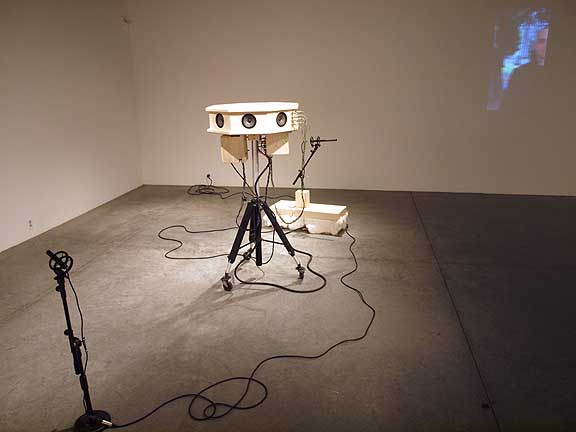 Pond (L), Slappe (R) Stephen Slappe's "Bear Witness" video is probably the most successful thing he's shown in town since "Crossroads" at the Art Gym last year. The constantly spinning camera in a cemetery with a strangely menacing figure interjected into the dizzying panorama does feel like coming across a stranger, bear, vampire, evil wizard or zombie in a graveyard… the figures are an engine of constant surprises that are unnervingly static despite the spinning scene. Moments where the figure shows his teeth are also reminiscent of the horror films that Slappe loves and studies. Overall, Bear Witness is a solid kinesthetic video piece that makes me wish it were projected a bit larger. Its effect in the gallery is wonderful as one continually catches glimpses of it… an inspired choice for this group show. Lastly, Victoria Haven's work takes up a corner. Her "Double or Nothing" works like an architectural doodle, rendered as sculpture and it's the shadows it throws which remind the viewer of the gallery lighting choices… a nice bit of curatorial porn. It's interesting but still not one of her best works, falling into that old Seattle trap of fine execution, while somehow not risking enough on the journey to finished work. Her 6 photos of sculptures called Oracle I-5 also feel like photos of Olafur Elliason's sculptural studies. Haven's work used to knock me out in 2002 but maybe I am just jonezing for a major boundary pushing installation by her… something her inclusion in any group show can't really sate. Overall, Vantage (which closes today) encouraged me to wander around, visit multiple times and contemplate after I left. I've been obsessed with the existential experiences and encounters one has in space for decades now and Vantage, though hardly as defining as Chinati, Spiral Jetty, Double Negative or Picasso's Les Demoiselles De Avignon it feels like a show I'll think about year after year. Well done. Posted by Jeff Jahn on February 06, 2010 at 14:18 | Comments (0) Comments Post a comment Thanks for signing in, . Now you can comment. (sign out)
(If you haven't left a comment here before, you may need to be approved by
the site owner before your comment will appear. Until then, it won't appear
on the entry. Thanks for waiting.)
|
| s p o n s o r s |
 |
 |
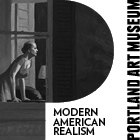 |
 |
 |
 |
 |
 |
 |
 |
 |
 |
 |
 |
 |
 |

|
Site Design: Jennifer Armbrust | • | Site Development: Philippe Blanc & Katherine Bovee | |

